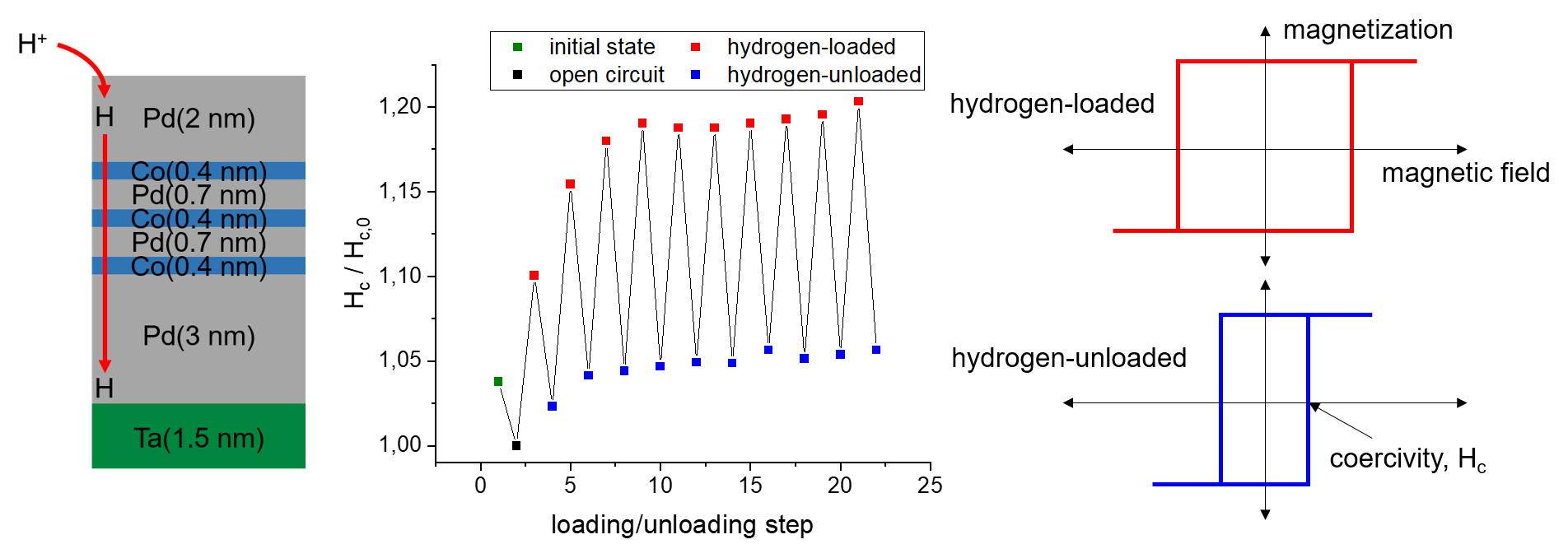Wasserstoff-Magneto-Ionik
Magneto-Ionik ist ein Forschungsfeld in dem magnetische Eigenschaften über elektrochemische Reaktionen gesteuert werden können (mehr dazu hier). Typischerweise sind elektrochemische Reaktionen auf die Elektrodenoberfläche limitiert, was elektrochemische Veränderung von magnetischen Eigenschaften im gesamten Probenvolumen erschwert. Dies wird deutlich, wenn man eine dünne Rostschicht an der Oberfläche eines Eisenmagneten betrachtet, die sich bei Kontakt mit Wasser und Luft and dessen Oberfläche (elektrochemisch) bildet. Der Magnetismus des Eisenmagneten kann dadurch kaum verändert werden. Um große magneto-ionische Effekte zu erzielen sind daher Proben mit einem großen Verhältnis von Oberfläche-zu-Volumen von Vorteil, wie es zum Beispiel in nanostrukturierten Materialien oder Dünnfilmen erreicht werden kann. Solche Probengeometrien werden auch bei uns in der Arbeitsgruppe durch elektrochemische Abscheidung hergestellt (Näheres dazu finden Sie hier). Eine weitere Möglichkeit magneto-ionische Effekte zu vergrößern ist die Nutzung von Interkalationsreaktionen, welche den Einbau von Ionen oder Atomen ins Kristallgitter bezeichnen. Solche Reaktionen erlauben es nicht nur die Elektrodenoberfläche, sondern das gesamte magnetische Volumen elektrochemisch zu beeinflussen.
Materialen für Interkalationsreaktionen umfassen Batterieelektroden, welche große Konzentrationen an Li-Ionen aufnehmen können, oder auch Reinmetalle wie Nickel oder Palladium, welche Wasserstoffatome im Kristallgitter einlagern können. In unserem Labor erforschen wir solche Lithium- und Wasserstoff-interkalierende Materialien für neuartige magneto-ionische Anwendungen. Im untenstehenden Bild ist ein Beispiel für einen magneto-ionischen Effekt basierend auf dem Einbau von Wasserstoff dargestellt. 
Eines unserer aktuellen Forschungsthemen ist der Effekt der Wasserstoffbeladung in eine Schichtstruktur aus Pd/Co (links), welche von der Arbeitsgruppe von Prof. Hellwig zur Verfügung gestellt wird. Palladium kann nicht nur große Mengen an Wasserstoff im Kristallgitter aufnehmen, sondern führt auch zur magnetischen Kopplung der benachbarten Co-Schichten, was für diesen magneto-ionischen Effekt genutzt wird. Madeleine konnte in ihrer Projektarbeit eine Erhöhung der Koerzitivfeldstärke dieser Schichtstruktur bei Wasserstoffbeladung von 20% nachweisen, welche reversibel über mehrere Lade- und Entladezyklen geschalten werden konnte (Mitte). Zum besseren Verständnis sind die magnetischen Hysteresekurven (Magnetisierung in Abhängigkeit vom Magnetfeld) im wasserstoffbeladenen und -entladenen Zustand rechts schematisch dargestellt.
Kontakt:
Dr. Markus Gößler
Tel.: +49 (0) 371 531 37533
E-Mail: markus.goessler@…
Raum: 1/150
- M. Gößler, S. Topolovec, H.Krenn, R. Würschum, Nanoporous Pd1-xCox for hydrogen-intercalation magneto-ionics,
APL Mater. 9,041101 (2021), https://doi.org/10.1063/5.0039136 - M. Gößler, M. Albu, G. Klinser, E.-M. Steyskal, H. Krenn, R. Würschum, Magneto-Ionic Switching of Superparamagnetism, Small 15, 1904523 (2019), https://doi.org/10.1002/smll.201904523





